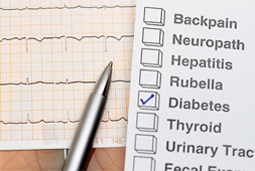Being Overweight: Reducing the Risk of Getting Type 2 Diabetes
 Diabetes is a serious health condition that people often overlook and also ignore because they are unaware of the facts surrounding the disease and how it can drastically affect their lives. You may be optimistic and think it couldn't happen to you, but it can if you have neglected your health. Here are some facts on the connection between overweight and diabetes and steps you can take to minimize your risk of diabetes.
Diabetes is a serious health condition that people often overlook and also ignore because they are unaware of the facts surrounding the disease and how it can drastically affect their lives. You may be optimistic and think it couldn't happen to you, but it can if you have neglected your health. Here are some facts on the connection between overweight and diabetes and steps you can take to minimize your risk of diabetes.
How Being Overweight Affects Diabetes
Being overweight is a distinct indicator of poor health and greater risk of health problems, especially diabetes. One factor that influences the onset of diabetes is insulin sensitivity. Good health denotes high insulin sensitivity, but obesity has been shown to negatively affect insulin sensitivity which leads to higher levels of blood glucose and sequentially the development of type 2 diabetes. With a diagnosis of diabetes, your body succumbs to insulin resistance and is unable to produce insulin properly. As a result, blood glucose levels may become uncontrollable with the absence of adequate insulin supply, and serious complications may occur. Diabetes and obesity also induce plaque buildup of fats in the bloodstream that hardens arteries and increases blood pressure. Early diagnosis of diabetes is essential in order to limit the negative effects it has on the body, which can be life-altering and life-threatening.
Steps To Reduce The Risk Of Diabetes
It is clear that diabetes must be avoided at all costs, and it is never too late to start making changes to improve your health to avoid it. Apart from the traditional recommendations to adopt a nutritious diet and a regular exercise routine, there are many other things you can do to minimize your risk of diabetes. Here are some strategies to guide your upcoming efforts in healthier living.
1. Get Educated
It has been said many times and it's true - knowledge is the key to prevention, especially in the case of obesity. Most people know the basics regarding the causes of obesity, but they are not informed of how it leads to other health problems. There are many ways to minimize the chances of diabetes as well as other health risks associated with being overweight, and knowing what these actions are can help prevent the onset of diabetes. Becoming well-versed in health means seeking out the facts through research and communication with others on experiences and proven causes and methods of prevention. To expand your knowledge on diabetes and diabetes prevention, search the web and discover what factors contribute to diabetes, such as unhealthy diet, sedentary lifestyle, high blood pressure, and high cholestorol.
2. Start Resistance Training
Research has proven that exercise helps decrease insulin resistance, which is an indicator of prediabetes. Insulin resistance occurs when the body does not use insulin correctly, which results from glucose buildup in the blood. The body cannot properly regulate unused glucose without adequate physical activity. Through exercise, muscles absorb more glucose and control blood glucose levels. Resistance training in particular has been proven to prevent insulin resistance , as it improves glucose tolerance. While aerobic exercise provides similar benefits, resistance training may be a favorable alternative for some people as these muscle conditioning exercises can be performed more easily with any physical limitations such as obesity, injury, or pregnancy.
3. Decrease Glycated Hemoglobin
Typically, hemoglobin transports oxygen and carbon dioxide in and out of the lungs. Hemoglobin A1c, or glycated hemoglobin, forms when blood glucose levels are high and glucose binds to the hemoglobin. Higher levels of hemoglobin A1c indicate decreased blood sugar control, which may lead to diabetes if untreated . In order to check your glycated hemoglobin level, have the hemoglobin A1c test, which determines the level of blood sugar control over the past three months. The normal level is up to 5%, and a result any higher requires immediate action. To reduce your hemoglobin A1c level, regularly consume low-glycemic foods and control portion size. Foods suggested by the American Diabetes Association to achieve this include beans, dark green leafy vegetables, citrus fruits, sweet potatoes, berries, tomatoes, fish, whole grains, nuts, and low-fat milk or yogurt.
4. Improve Cholesterol Levels
While cholesterol generally is perceived as bad, there are both "good" and "bad" types of cholesterol. Increased levels of bad cholesterol increase the risk of many diseases, including diabetes. Having balanced cholesterol levels will decrease your risk of diabetes and further health problems, as diabetes increases the likelihood of cardiovascular diseases assocated with poor cholesterol levels . To raise your good cholesterol, eat high-fiber foods such as oatmeal, low-fat dairy, foods fortified with plant sterols including orange juice or yogurt beverages, and foods with unsaturated fats like nuts or salmon. To lower bad cholesterol, avoid saturated fats including those in meat and full-fat dairy, and minimize your trans fats which are found in foods such as cookies, crackers, and cakes.
5. Seek Help for Eating Disorders
 Disordered eating is a problem that parallels the increasing rates of obesity, and it simultaneously contributes to diabetes. Referring to any means of eating that could or does physical or psychological harm, disordered eating attitudes and behaviors are twice as common in females with diabetes If you think that you may suffer from an eating disorder, ask your doctor and seek treatment to minimize your risk of getting diabetes.
Disordered eating is a problem that parallels the increasing rates of obesity, and it simultaneously contributes to diabetes. Referring to any means of eating that could or does physical or psychological harm, disordered eating attitudes and behaviors are twice as common in females with diabetes If you think that you may suffer from an eating disorder, ask your doctor and seek treatment to minimize your risk of getting diabetes.
6. Make Lifestyle Changes
In addition to hormonal and genetic predisposition, it is your individual lifestyle that influences your risk of diabetes. Overall health, health-related behaviors, and psychological functioning altogether may increase or decrease this risk , whether positive or negative. There are many strategies to adjust your lifestyle and behaviors to positively affect your health and decrease the risk of diabetes. Most important is having the proper attitude toward health improvement as a necessity. One attitude that the majority of people have is optimistic bias - that is, they believe they are less likely than others to suffer the negative consequences of their behaviors. With steadily increasing rates of obesity and diabetes, optimistic bias becomes more apparent as people have not adopted healthier behaviors that they have known about their entire lives. In a study of an Appalacian population, little perception of diabetes risk existed, despite its high prevalence in the state Even among diabetes patients, there is low perception of risk for diabetes complications , which may include cardiovascular disease, damage to nerves, kidneys, eyes and feet, skin and mouth conditions, as well as increased risk of osteoporosis, Alzheimer's disease, and cancer. As diabetes increases the risk of death from all medical complications, the severity of the disease cannot be underestimated, and everyone must be more aware of the associated risks and what can be done to minimize those risks.
The Importance Of A Healthy Weight
 Losing weight is the biggest challenge and most important step in mitigating your risk of diabetes. With increased knowledge comes the power to live healthier, and with healthier living through nutritional eating and other behavioral changes comes fewer health problems such as diabetes and other related issues. Decreasing your overall weight and maintaining a healthy weight will improve your health. You may be able to accelerate your weight loss with a nutraceutical such as Green Coffee Bean Extract - one clinical study showed that over a 22-week period, 16 overweight subjects lost an average of 17 pounds and 16% of their body fat without changing their diet or exercise. Choose the best weight loss strategy for you and witness the results that will increase your confidence and improve your overall persona.
Losing weight is the biggest challenge and most important step in mitigating your risk of diabetes. With increased knowledge comes the power to live healthier, and with healthier living through nutritional eating and other behavioral changes comes fewer health problems such as diabetes and other related issues. Decreasing your overall weight and maintaining a healthy weight will improve your health. You may be able to accelerate your weight loss with a nutraceutical such as Green Coffee Bean Extract - one clinical study showed that over a 22-week period, 16 overweight subjects lost an average of 17 pounds and 16% of their body fat without changing their diet or exercise. Choose the best weight loss strategy for you and witness the results that will increase your confidence and improve your overall persona.
1. Gabrielle N. Brankston et al, "Resistance exercise decreases the need for insulin in overweight women with gestational diabetes mellitus," American Journal of Obstetrics & Gynecology, 190, 188-93.
2. Claudia M. Toledo-Corral et al, "Hemoglobin A1c above threshold level is associated with decreased ß-cell function in overweight latino youth," The Journal of Pediatrics, 160, 751-6.
3. I. Idris and F. Al-Ubaidi, "Discordance between non-HDL cholesterol and LDL cholesterol levels in patients with diabetes without previous cardiovascular events," Diabetes & Metabolism, 36, 299-304.
4. Khalida Ismail, "Eating disorders and diabetes," Psychiatry, 7, no. 4, 179-82.
5. Susan Stone et al, "Behavioral characteristics among obese/overweight inner-city African American Children: a secondary analysis of participants in a community-based Type 2 diabetes risk reduction program," Children and Youth Services Review, 32, 833-9.
6. Irene Tessaro et al, "Knowledge and perceptions of diabetes in an Appalachian population," Preventing Chronic Disease, 2, no. 2, 1-9.
7. D. Calvin et al, "African Americans' perception of risk for diabetes complications," Diabetes Education, 37, no. 5, 689-98.
